Browse JIRA Projects
The "Browse JIRA Projects" dialog let you view and select a single project from the list. The list of projects is read from JIRA and is used throughout The Connector whenever you need to select a project.
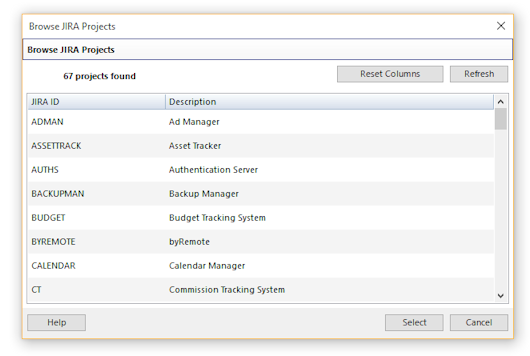
Simply highlight the project in the list and press the "Select" button or double click on the project in the list to select.
JIRA Task Browser
To access the Task Browser click on Tools - Task Browser. The Task Browser is a tool that allows you to quickly and easily look at and manipulate tasks.

By double clicking on Issue ID, Issue Type, Summary, and Priority on a Task in the list you are able to quickly edit that value.
The Task Browser Filters will limit what tasks appear in the browser.
Bulk Updates can be done from this screen as well. This is done by selecting the appropriate tasks from the list, either by using the select all / unselect all options or by using the ctrl / shift buttons and clicking on tasks with the mouse. Once the tasks are selected click on the option you would like to change in the Bulk Update list. Select the new value and click OK. Remember that after making these changes you will need to send the information to JIRA to update the tasks in JIRA.
To view a task in JIRA, simply click on the specific task and then click Goto Issue under the JIRA heading on the right. You can also access The Connector's Issue Editor by clicking that option under the same JIRA heading.
Lastly you are able to Search for a specific IssueID by typing it in the Search and then clicking on Find Issue. If the issue is in the Browser it will be highlighted in the list.
Select A JIRA Profile
The profile selection dialog is used to specify to The Connector which profile you want to use. Each process will only use a single profile at a time, however The Connector does allow you to configure as many profiles as you would like.

Selecting from this screen allows you to quickly toggle between different instances or configuration for JIRA.
Mark selected as default and do not prompt again: If you choose this option, the profile you select will be updated as your default profile and you will not be prompted anymore to select a profile. It will simply use the default profile automatically.
If you wish to have The Connector continue to prompt you again, you can uncheck this value from the Configuration screen.
Link Issue to Task
The Link Issue function will allow you to link existing project tasks with existing JIRA issues. This function is useful when you have tasks that have already been created in JIRA and/or are trying to repair a project plan that has been corrupted. You can also use this to build a complex project plan from issues that already exist by selecting tasks in Microsoft Project and linking them to their appropriate issue.
Select the task from your project plan. Be sure to select only one, if multiple tasks are selected you will receive a message that you can only select one task. Then click on Tools - Link Issue to Task. The Link Task To Existing JIRA Issue screen will appear. Simply type in the JIRA issue you wish to link to or use the "Browse JIRA Issues" to select the issue and click OK. Your project task will then be linked to the specified JIRA issue.

Compare
The compare function of The Connector allows you to compare an issue/task in Microsoft Project with the current values in JIRA. This will allow you to quickly and easily see the differences between the two.
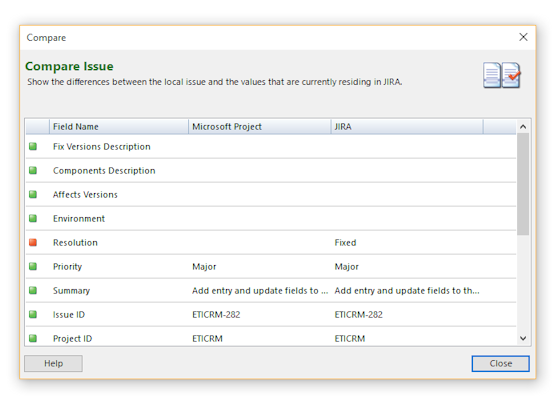
The compare function is available on both the Send and Update screens in the JIRA section in the upper right. A task must be selected in the task list for this to work.
Issue Editor
This issue editor is a dialog provided by The Connector for quickly and easily editing all of the information related to the issue in one place. From this dialog, you can also send and update the information from JIRA (by clicking where it says JIRA in the middle right side). From this window, all the attributes of the task/issue can be adjusted including all the custom field values, versions and components, sub-task information, and slave issue links. You can navigate from one issue to another using the First, Previous, Next, and Last options.
To exclude an issue from the JIRA sync, check the JIRA Ignored option in the upper right corner. If this option is chosen, this specific task will be skipped over whenever a JIRA data exchange is performed.
You may also use the View JIRA Issue link to directly go to JIRA to view more details about the issue.
The Edit Time and Click To Analyze options deal with the time / duration of the task.
Description
The Description text box on the first tab of the issue editor allows a place for you to modify the issue description. This information is stored in the "Notes" field of the Microsoft Project task and can also be edited through that screen.

General
Under the General tab of the issue editor, you can modify all of the basic properties of the issue such as its type, priory, status, assignee, and due date.
If you wish to make this task a sub-task, this can also be set from this screen (See the Working With Sub Task section for more information).
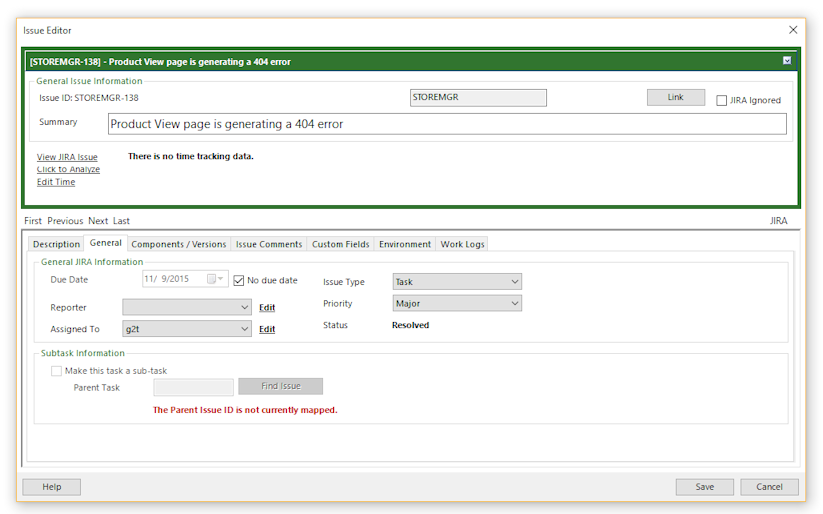
Components / Versions
The Components / Versions tab of the issue editor will allow you to select which components, affects versions, and fix versions with which the issue is associated.
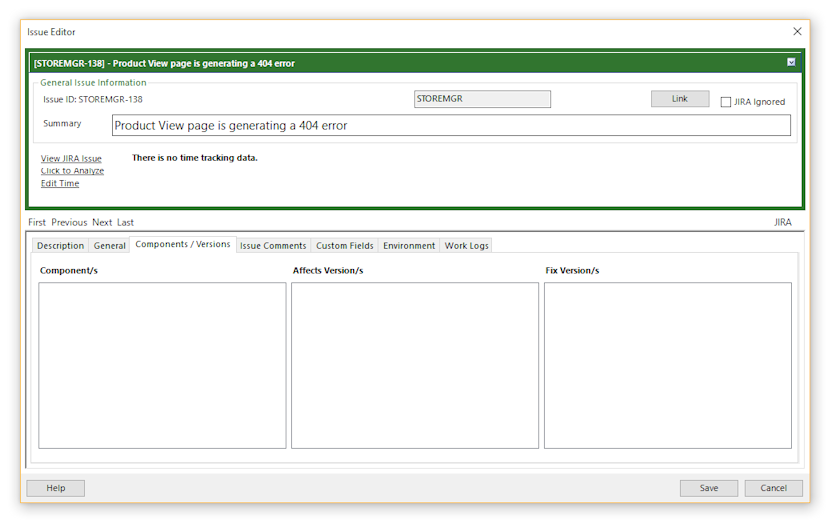
You will only see this option if it is enabled in the settings tab of the configuration screen. Select the desired components and versions, and when the issue is synchronized with JIRA, this data will be transmitted and updated.
Issue Comments
The Issue Comments tab of the issue editor will allow you to quickly view any comments that exists in JIRA for the current issue you are working with. Note: If you are creating a new issue that currently does not exist in JIRA yet, you will not be able to access any comments.
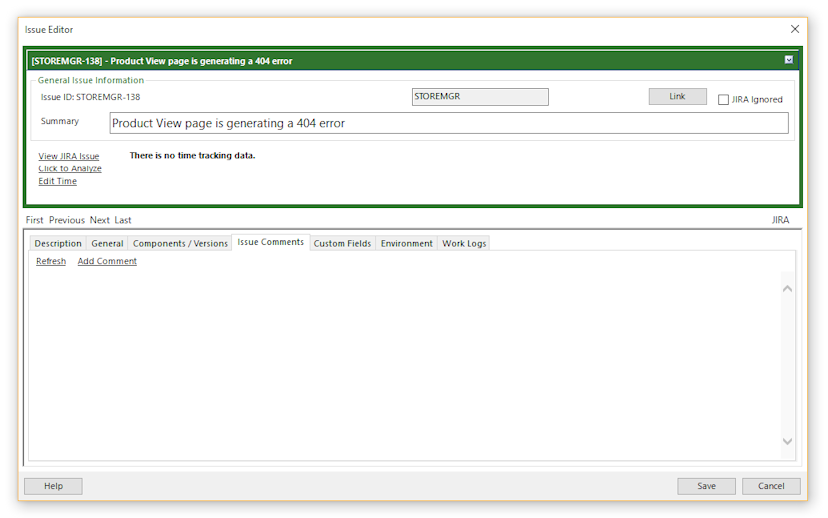
Clicking on Refresh will do an immediate query to JIRA to update the comments listed.
Custom Fields
The Connector supports Custom Fields in JIRA and allows you to exchange this information in both directions. From the Custom Fields tab of the issue editor you can view and set the values for custom fields. Most of the standard JIRA custom fields are supported by The Connector and allow for their native types to be edited through The Connector.
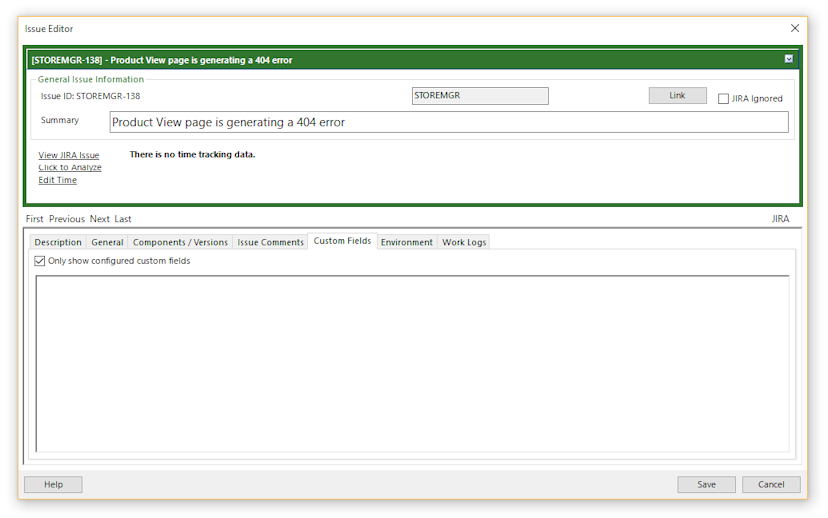
If your custom field is a multi select list box, The Connector shows you a multi select list box and allows you to select multiple values. Date/time fields are shown in The Connector using the Windows date selector.
Only show configured custom fields: Your JIRA instance can have more custom fields setup than you wish to use in The Connector. If you only configure The Connector to use 3 of those custom fields, checking this option will limit the fields you see to the configured fields. This is useful if you have a large number of custom fields setup in JIRA but don't want or need to see them from within Microsoft Project.
Environment
The Environment tab of the Issue Editor will allow you to edit the environment value of the JIRA issue. This tab is only visible if you have enabled this option through The Connector's configuration dialog.
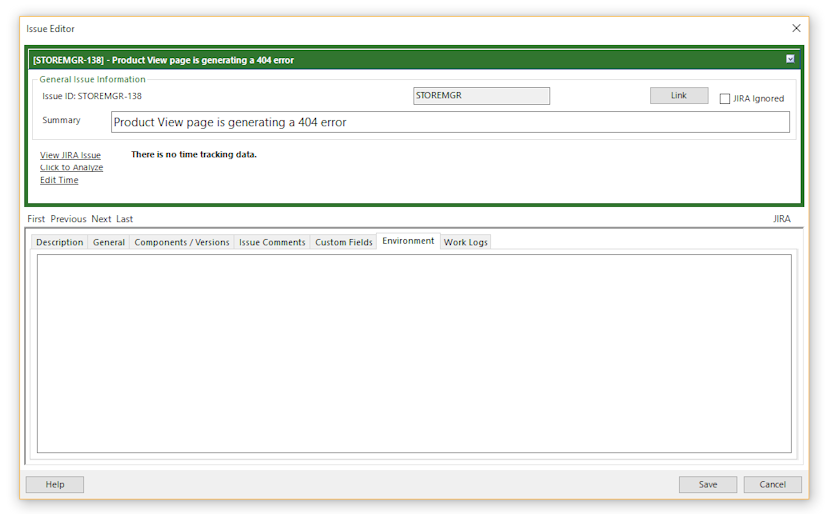
NOTE: You CANNOT use tab or carriage returns in the environment field and you can only store 255 characters. This is a limitation to the storage location in Microsoft Project.
Work Logs
The Work Logs tab of the issue editor will allow you to quickly view any work log detail that exists in JIRA from the current issue you are working with. Note, if you create a new issue that currently does not exist in JIRA yet, you will not be able to access any work logs.
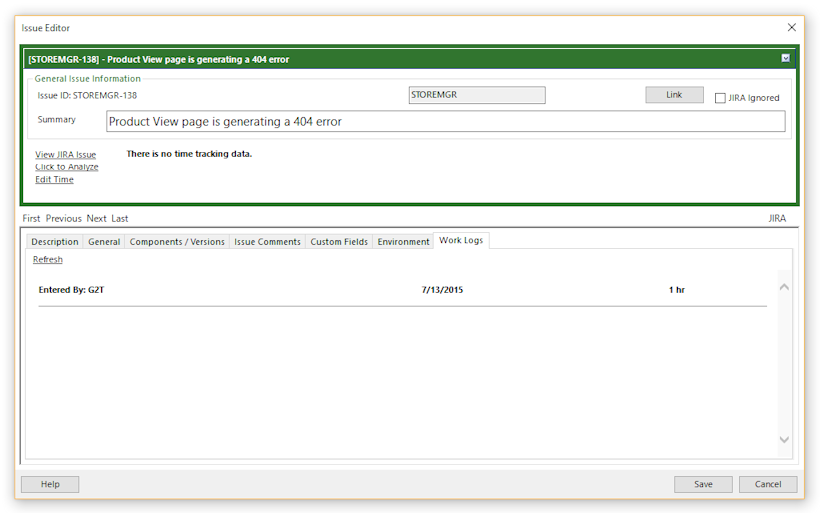
Slave Project / Issue
If you have the slave project / issue option enabled, this tab will allow you to specify the issue ID and project of the slave issue. A slave issue is simply a secondary issue that gets updated at the same time as the master issue effectively causing two JIRA issues to be updated with the same information during the Send To JIRA process.
Analyze and Edit Time
The Edit Time dialog allows you to enter in the duration data for the JIRA issue. You can edit the original estimate, remaining estimate or time spent values.
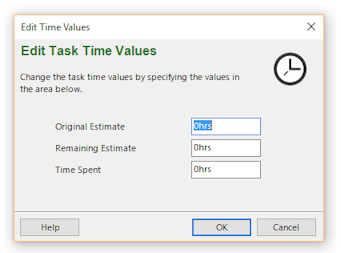
The Duration Analyzer will show you details on how it had calculated your task duration. This functionality can be helpful to determine/debug how your settings are affecting your JIRA data for time tracking.
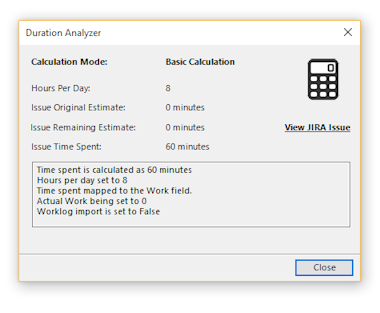
The various calculation modes of The Connector can cause different duration values to get used. The advanced topic on Duration and Work describes in detail how these calculations are done.